The Legend of Zelda is a video game release for the NES in 1983 by Nintendo. It's
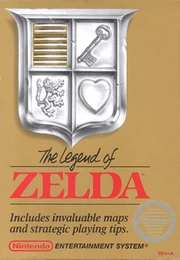
The Legend of Zelda
considered a classic by today's standard, and has spanwed many sequels, prequels, and spinoffs over the years since the game's initial release.
Hyrule[]
While certain landmarks of Hyrule commonly return, Hyrule's geography appears to be laid out
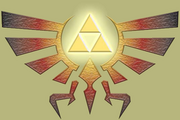
Hyrule Symbol
differently with almost every new game set in it. Parts of Hyrule found in one game's map may be in a different location, have different geographical features, or be completely absent in another. While some games may take into account the geography in past Zelda games (A Link to the Past and Four Sword Adventures share almost the same Hylian geography) others may completely ignore them (The Minish Cap's Hyrule bears almost no resemblance to any other game). Several fan explanations have been given. The first is that the changes occurred because of geological events between the games such as earthquakes, mudslides, erosion, forest growth, continental drift, or all of the above. The second theory is that Hyrule's geography stays relatively the same but that each new game shows the same Hyrule seen from a different angle, that landmarks are renamed, or that other unseen parts of Hyrule are seen each game. Some fans argue that while Hyrule does change from game to game it is simply due to gameplay
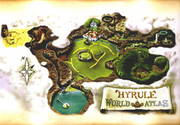
Hyrule Map
reasons to give players something new to explore while staying in the same land and has no real in-game explanations.
It is also possible that different parts of Hyrule are shown throughout the various games. In The Legend of Zelda comics, the map from Zelda II: The Adventure of Link is added to the north of the map found in The Legend of Zelda, and the in-game map for Zelda II: The Adventure of Link also has an area that resembles a scaled down version of the map in The Legend of Zelda. The geography then allows the map from A Link to the Past to be included to the west.
Sheikah[]
The Sheikah are first introduced in Ocarina of Time, but in The Legend of Zelda and Zelda II: The Adventure

of Link, there is a character called Impa, who is the attendant of Princess Zelda. There are no indications that this Impa is of the Sheikah race, owing to the fact that she does not have red eyes in the game's official artwork. This could be a case of retcon byNintendo, because there are certain similarities between Impa fromOcarina of Time and the one appearing in The Legend of Zelda andAdventure of Link. They both have considerable knowledge of Hyrule, Ganon and the Royal Family.
thumb|left|link=Zelda II: The Adventure

of Link, there is a character called Impa, who is the attendant of Princess Zelda. There are no indications that this Impa is of the Sheikah race, owing to the fact that she does not have red eyes in the game's official artwork. This could be a case of retcon byNintendo, because there are certain similarities between Impa from Ocarina of Time and the one appearing in The Legend of Zelda and Adventure of Link. They both have considerable knowledge of Hyrule, Ganon and the Royal Family.
Alternatively, according to the Legend of Zelda timeline, the events of The Legend of Zelda and its sequel Zelda II: The Adventure of Link from the NES games, take place after the time line splits into three branches based upon the outcome of The Legend of Zelda: Ocarina of Time. If the Hero is defeated in The Legend of Zelda: Ocarina of Time then the next games in the time line are The Legend of Zelda: A Link to the Past, The Legend of Zelda: The Oracle of Ages, The Legend of Zelda: The Oracle of Seasons, The Legend of Zelda: Link's Awakening, then Zelda I and Zelda II. This could mean since the original NES games are the last in the game series' "defeated hero" time line, then the characteristic features of the Sheikah race of the red eyes and tanned skin, may have been lost over time by interbreeding with other races. It is already known that the characters of Zelda, Link, Impa, and others are not the same ones in all the games throughout the series. The Link in The Legend of Zelda: Ocarina of Time and The Legend of Zelda: Majora's Mask are the same in those two games, but it is not the same Link as the Link who appears in The Legend of Zelda: The Wind Waker and The Legend of Zelda: Phantom Hourglass, those each being the same Link in those two games, but at a much later time period (and a different/parallel timeline to the one cited above). As a result, the Impa that appears in the NES games, may not be a pure blooded Sheikah and therefore, possesses characteristics of both the Hylian race and the Sheikah race. As a result of her being a descendant of the Sheikah though, she still possesses the knowledge and training of the Sheikah people. We already know the Sheikah were a rare race in The Legend of Zelda: Ocarina of Time and naturally became even fewer over the period of time that followed. If the Sheikah and Hylian's were originally the same race that differed over time after a split between them occurred, it would be only natural for those characteristics distinguishing one from the other to merge and blend if they were joined back together at a later time.
Darknut[]
It is possible that the Japanese for Darknut, タートナック (Tātonakku), was intended to
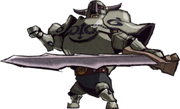
Darknut
represent the English words "Dark Knight," especially considering the nature of the enemy in question and Japanese conventions for representing English with katakana. The localization team may not have realized what the katakana was attempting to borrow from English, with the series recycling the original mistranslation throughout the games rather than correcting it. However, this raises the question of why ダークナイト (Dākunaito) was not simply used instead, as it more accurately represents "Dark Knight" phonetically.
It should also be noted that Darknut and Iron Knuckle アイアンナック (Aiannakku) share the same katakana ending. This poses further questions as to the translations of both names: Darknut could have been "Dark Knuckle", and Iron Knuckle could have been "Iron Nut" or "Iron Knight".
Death Mountain[]
Death Mountain (デスマウンテン Desu-Maunten?, Hylian DHylian EHylian AHylian THylian HHylian
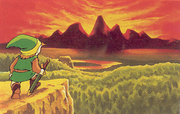
Death Mountain
SpaceHylian MHylian OHylian UHylian NHylian THylian AHylian IHylian N) is a recurring location in the Legend of Zelda series. A huge mountain or mountain range that is typically the highest geographical point of Hyrule, Death Mountain has become a well known location within the series, and serves as the homeland of the proud Goron race in most games. Occasionally, entry to Death Mountain is restricted; one must receive permission from the Royal Family of Hyrule to enter the mighty mountain. It is generally believed that the name Death Mountain is used for many different mountains in the series, but because some of its appearances share certain geographical or topographical similarities, some Death Mountains are believed to be one and the same.
Dragon Roost Island[]
It is believed that Dragon Roost Island, an island in The Legend of Zelda: The Wind Waker, is
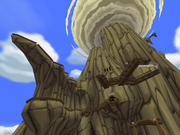
Dragon Roost Island
Death Mountain. Prior to the events of The Wind Waker, most of Hyrule was flooded and buried at the bottom of what came to be known as the Great Sea. However, the tall Death Mountain managed to stay above water. Gorons have long since left their traditional dwelling, disguising themselves as Traveling Merchants. Instead, the Rito race, a race confirmed to be descendants of the Zora, live here in dwellings cut into Dragon Roost Mountain. The first dungeon, Dragon Roost Cavern, is believed to be Dodongo's Cavern. Dragon Roost Island is not an active volcano like Death Mountain, but there is a small volcano directly south of it called Fire Mountain. Another fact that supports this theory is the existence of Bomb Flowers that grow in Dragon Roost Island as well as in Death Mountain.
Eldin Volcano[]
It is also widely believed that Eldin Volcano from The Legend of Zelda: Skyward Sword was later renamed Death Mountain, as it is the only mountainous area in the land that would eventually be known as Hyrule.
Hero's Clothes[]
Because the Link in The Legend of Zelda: Skyward Sword was the first hero chosen by the Gods,

Hero's Clothes
and the knights are seen wearing the Hero's Clothes, it is possible that this is where they originated from, and from this Link they have been passed down. It is more likely however, that the Hero of Time was the one who passed down the idea as shown in Wind Waker and Twilight Princess.
Knights of Hyrule[]
It is possible that the Knights of Hyrule trace their origins back to the Knights of Skyloft

Knights of Hyrule
from The Legend of Zelda: Skyward Sword as a means of protecting the citizens of Hyrule. The Hylian Shield as well as the Knight's Crest bears a bird motif, possibly representing the Loftwing, further supporting this idea.
Level 1(First Quest)[]
Level 1, also known as "The Eagle", is the first dungeon in The Legend of Zelda. It is sometimes also known as "The Eagle", owing to the fact that its map layout is shaped like an eagle; common shapes is a prevalence in the design of most of the dungeons in the game.
Normal Theory[]
After Inside the Deku Tree was seen in The Legend of Zelda: Ocarina of Time, some fans started

Level 1(First Quest)
speculating that Level 1 is set inside a dead Deku Tree. However, there is little actual evidence for this, and coupled with the fact that no form of a Deku Tree appeared until Ocarina of Time, it seems that this theory is unlikely. However, there is no technical reason this theory could not be true.
Possible Inspiration[]
In Norse mythology, a dragon named Níðhöggr lives under the tree Yggdrasil and eats its roots, while an eagle lives on top of the tree. Level 1's shape resembles that of an eagle (hence its nickname). There may be a connection to this myth due to the dungeon's entrance being a tree, its interior being shaped like an eagle, and its boss being a dragon.
Level 1(Second Quest)[]
After Inside the Deku Tree was seen in The Legend of Zelda: Ocarina of Time, some fans started speculating that Level 1 is set inside a dead Deku Tree. However, there is little actual evidence for this, and coupled with the fact that no form of a Deku Tree appeared until Ocarina of Time, it seems that this theory is unlikely. However, there is no technical reason this theory could not be true.
Link[]
Reincarnation[]
A common theory as to why each incarnation of Link looks similar and have similar abilities is
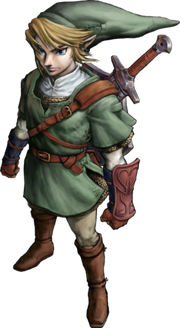
Link
that they are reincarnations of one another. It is notable that when Demise put a curse onto the Skyward Sword, Link, and Zelda, he stated "Those like you... Those who share the blood of the goddess and the spirit of the hero." which may have been referring to reincarnation. It should be noted however, that Link from The Wind Waker could not be the reincarnation of the Hero of Time since the latter went to the Child Timeline and effectively disappeared from the Adult Timeline. According to the King of Red Lions, the Hero of Winds has no connection to the Hero of Time, though it is unclear whether he is referring to blood relation or reincarnation with this statement. It is worth noting that Ganondorf believes the Hero of Winds is the Hero of Time reborn, though his claim has no concrete evidence. Link from Twilight Princess also could not be the reincarnation of the Hero of Time since, according to Hyrule Historia, he not only met the Hero of Time as the Hero's Shade, but is however his descendant.
Relatives[]
Another theory as to why each incarnation of Link looks similar to one another is that they are actually related to one another. This is supported by the fact that the Hero of Time is the ancestor of Link in Twilight Princess as well as how it is stated in A Link to the Past that the Master Sword can only be pulled out from its pedestal by the ones who carry the bloodline of the Knights of Hyrule. It is possible that when Demise stated "Those like you... Those who share the blood of the goddess and the spirit of the hero," when he put a curse on Link and Zelda, he was actually referring to the "spirit of the hero" as a form of will or a set of personality traits rather than the soul itself. If this is the case, this could explain each Link's connection with the Triforce as well as their abilities in physical, mystical, and spiritual ways.
This may mean when he was stating "Those who share the blood of the goddess" he was referring to Skyward Sword Link and Zelda's descendants as the other incarnation of Links rather than the Royal Family of Hyrule, where an alternate reason for the Royal Family having magical powers is the Light Force as hinted in The Minish Cap. This would explain why Link faces other adversaries aside from Ganon, with Zelda (or other members of the Royal Family) sometimes not being present to support the side of good in games such as as Majora's Mask, Link's Awakening and Tri Force Heroes The original Japanese text that Demise states is that his hatred and the Demon Tribe will go under an "evolution", which may mean the curse could involve other villains apart from Ganon himself.
If each Link is related to one another, they need not be related along a single line of descendants. For example, the Hero of Winds cannot be a direct descendant of the Hero of Time since the latter returned to the Child Timeline immediately after his victory over Ganon while being a young preteen in a teenager's body, but provided the Hero of Winds can trace his lineage to Skyward Sword Link, the theory still holds. It is possible that the reason why the Master Sword can only be pulled from it's pedestal by someone who carries the bloodline of the Knights of Hyrule is actually a sub-conscience decision by Fi, who is the spirit of the Master Sword.
Madas[]
It is possible that in the contemporary Hylian language during the events of Skyward Sword, Link's name may be "Madas" when pronounced. This would explain why Fi, when talking to Link in dialogue that uses his name, often says "Madi Madas" with "Madi" possibly being "Master" in the language. Alternatively, it is possible that Fi's words are gibberish used repetitively in the game, similar to Midna in Twilight Princess.
The Lost Woods[]
The Lost Woods is a recurring location in the Legend of Zelda series. This mysterious, forested
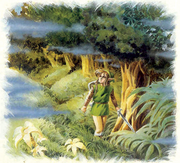
The Lost Woods
region of Hyrule is typically a maze-like forest that requires one to navigate one's way through it by a variety of means.
The Legend of Zelda: The Wind Waker[]
It is theorized by some that the Lost Woods became the Forbidden Woods. Evidence supporting this theory is that the Lost Woods from Ocarina of Time are near Kokiri Forest, and that the Forbidden Woods from The Wind Waker are near the Forest Haven. The Kokiri Forest and the Forest Haven are theorized to be the same place, since they have similar climates and both are home to the Great Deku Tree. Also, there are stump-shaped houses inside the Forbidden Woods which look very similar to the houses of the Kokiri in the Kokiri Forest from Ocarina of Time, and a Korok tells Link that he may see some of their old houses in the Forbidden Woods.
The Legend of Zelda: Twilight Princess[]
The Sacred Grove in this game is believed by many to be part of the Lost Woods. Though this has
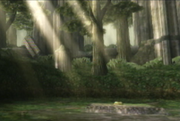
The Sacred Grove
never been officially stated; they carry identical music themes, and both woods are roamed by the Skull Kid. One of the biggest similarities between the Lost Woods in Ocarina of Time and the Lost Woods in Twilight Princess is that the area which holds the Master Sword in the Sacred Grove is exactly the same as the area where Saria sits in the Lost Woods in Ocarina of Time.
Both areas in each game are high, circular chambers deep in the forest. Also, when Link looks up in the Sacred Grove, he can actually see what appears to be the Forest Temple from Ocarina of Time, which appears as an immense archway. There is also a room with a bomb-able rock hiding an Imp Poe and the entrance to a Dig Cavern which also resembles this area.
Magic Sword[]
Although unconfirmed, it is possible that the Magical Sword formed the basis for the Master

Magic Sword
Sword of later games, as it is the third, final, and most powerful sword in the game. Some fans believe them to be one and the same.
Multiple Ganon Theory[]
The Multiple Ganon Theory is the theory that there exists more than one Ganon/Ganondorf in the Zelda timeline, in much the same way that Link and Princess Zelda exist as more than one person throughout the Legend of Zelda series. Variations include ideas that Ganondorf is locked in the same cycle of reincarnation as Link, or that Ganon is a malevolent demon who possesses people, Ganondorf being one such host. Supporting the reincarnation idea, it is said by the Gerudo that only a single male is born into their tribe every one hundred years. Depending on the game, he is said to be destined to become either the King of the Gerudo or the guardian of the desert and the Gerudo.
Although the theory has been around for quite some time, most modern versions of this theory stem out of Ganondorf's back-story in The Legend of Zelda: Four Swords Adventures, which conflicts with Ganondorf's back-story in The Legend of Zelda: Ocarina of Time. In Four Swords Adventures the Gerudo talk about a man named Ganondorf who had been born and lived in the Desert of Doubt with them. They mentioned that he had grown into an evil man with a lust for power and had broken their laws by stealing a Trident deep in the desert that gave him incredible powers, such as transforming him into Ganon.
This is in direct contrast to the back-story Ganon was given in Ocarina of Time, in which he is acknowledged by many as the king of the Gerudo, and does not become Ganon until acquiring the Triforce of Power. Additionally, the back-story of The Legend of Zelda: Twilight Princess, which explains the actions of the Ganondorf from Ocarina of Time in an alternate timeline, says that a tribe of thieves, most likely the Gerudo, followed him in his attack on Hyrule, again showing that he was accepted as king.
There are only three logical explanations to these conflicting back-stories:
One is that a single Ganondorf had ventured to the desert and stolen the Trident, broke out of the seal he was placed at at the end of Four Swords Adventures but was not killed by Link, turned back into Ganondorf, and returned to the Gerudo later at a time that they were willing to acknowledge him as king. This would require that Four Swords Adventures take place before Ocarina of Time. The second explanation is that the game is not part of the overall storyline within the series, though official statements indicate that all the games from the main series are included in the official timeline document. The third explanation is that the Ganondorfs from the two games are separate incarnations, much like the many Links, Zeldas, and other characters who are seen multiple times throughout the series. This theory is supported by a quote at the end of Four Swords Adventures in which Princess Zelda calls Ganon an "ancient demon reborn". This is similar language to a line in The Legend of Zelda: The Wind Waker in which Ganondorf calls the game's incarnation of Link "The Hero of Time, reborn". Another solid point for this theory is the apparent death of Ganondorf/Ganon five separate times throughout the series. An individual Ganon is only shown to be resurrected once. Even with this resurrection, and the split timeline allowing a single individual Ganon to die twice, there would still need to be three separate Ganons in order to account for all of the presumed deaths. In order for all of the Ganons in the series to be the same, Ganon would have to have been brought back to life on two additional occasions not hinted at by any of the games, or survived at least two of his apparent deaths.
In The Legend of Zelda: Skyward Sword, Demise states that his hatred will be reincarnated and attack in a cycle without end. This is often interpreted as meaning that Ganon's repeated appearances are a result of this cycle. If Ganon as we know him is a result of Demise's hatred continuously reincarnating itself, there would be further support for the idea that multiple Ganons could continue to appear even as previous ones are slain. This would support the Multiple Ganon Theory as each Ganon would be a separate incarnation in this cycle, though all of them would share the same basic origin of forming from Demise's hatred.
While the Multiple Ganon Theory has yet to gain wide spread acceptance, it has nonetheless gained the respect of some timeline theorist and fans of the series.
Shigeru Miyamoto has stated that although each Link and Zelda are reincarnations, there is "only one Ganon". However, this statement may now be outdated or may have been made based on a lack of information, as Miyamoto is no longer as involved with the Zelda storyline as he previously was.
According to the Hyrule Historia, a second Ganondorf is born during the events leading to Four Swords Adventures. The book either implies or states directly that the rest of Ganon's appearances are the same being brought back to life, or versions of him in alternate timelines.
Royal Family of Hyrule[]
The Royal Family of Hyrule does not appear in this game, however, the game's end implies its
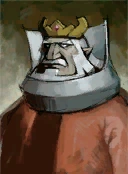
creation. Zelda, not as a princess, but as the daughter of Skyloft's Headmaster, and Link stay on the surface after the destruction of Demise, and are implied to form the kingdom of Hyrule, presumably with Link and Zelda as the ruling family. The sacred status of the Hyrule Royal Family may be seen as its connection to Hylia.
Silver Arrow[]
Silver arrows may have been inspired by Silver Bullets, which are often the only weapon capable

of defeating werewolves, witches, or other fictional monsters in folklore.
Spectacle Rock[]
Spectacle Rock, located at the summit of Death Mountain, presumably appears as an island on the
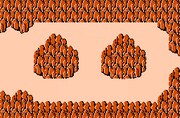
Great Sea known as Spectacle Island. The Great Sea, the country in which the game is set, was in truth created when Hyrule was flooded by the Gods. Spectacle Rock, the very top of the tall, tall Death Mountain, is the only surviving landmark of that area. However, there is a conflicting theory that Dragon Roost
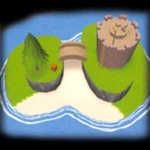
Island is Death Mountain, due to the ring of smoke seen on Link's first visit there and the fact that it is a volcano, as well as the fact that it is taller than all other Islands in the game.
Split Timeline[]
It is speculated by some that alternate worlds such as the Twilight Realm and Termina may be unaffected by the timeline split. However, while these two realms are alternate dimensions, there is no evidence to support the idea that they exist outside of linear time. Both realms have demonstrated the ability to receive beings from the Child Timeline and return them to the Child Timeline when they exit back into Hyrule. There is no reason to believe that these two realms would only exist as a single timeline, or that they could "prioritize" inputs from one timeline, and later output these into both the timelines.
In addition, the renowned Youtube show, Game Theory, dismissed the Zelda Timeline, particularly the Defeat Timeline (in where Link fails on his quest) on the grounds that "the hero cannot be simultaneously victorious and defeated". Elaborating, he explained that with Link defeating Gannondorf, two perfectly possible timelines are created; However if Link dies at any point in his journey another separate timeline is created. Explaining that the only way for all 3 timelines to exist is the Many Worlds Theory (the theory that all possible pasts and futures exist in separate timelines).
Timeline[]
"Just a Legend" Theory[]
Some fans say that the chronology of the series should not be so rigid. Just as real-world legends are retold with different variations (e.g. the flood), each game could merely be a different retelling of the same story. With each advancement in videogame hardware and the ever-changing desires of the consumer, the base story of Link saving Princess Zelda from Ganon and recovering the Triforce is embellished, modified, and changed outright. Just like any other legend, The Legend of Zelda changes as it is retold through the years. Despite the fact that Aonuma and Miyamoto have confirmed the existence of a timeline, this remains a popular theory.
